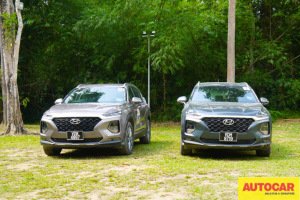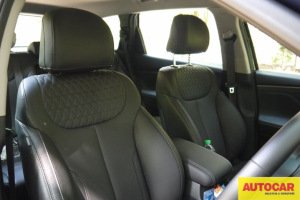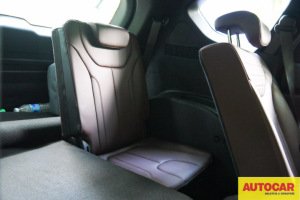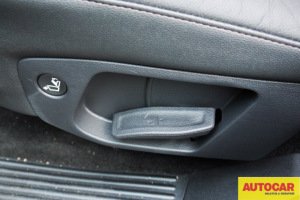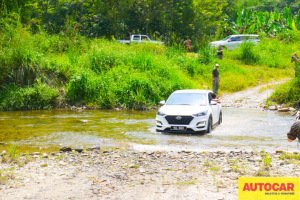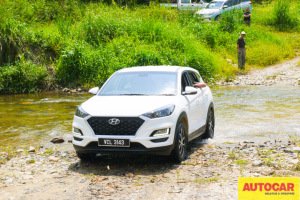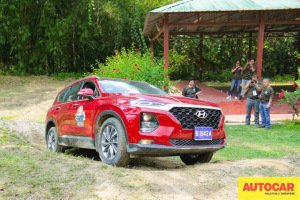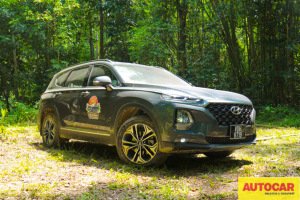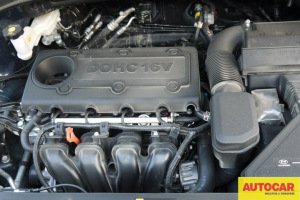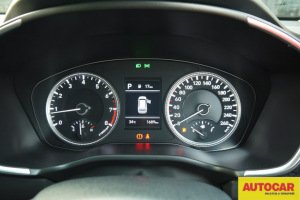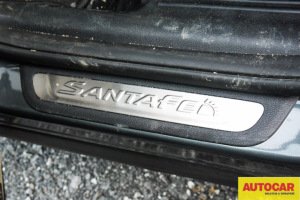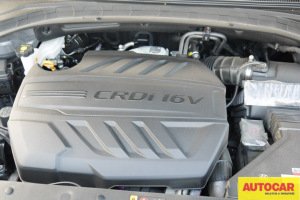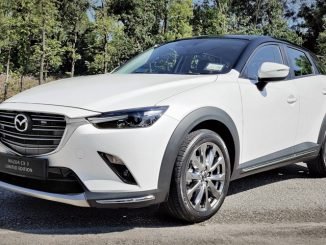
Two-wheel drive or four-wheel drive, is 4WD really necessary, how far can a 2WD SUV get you off-road? Lisa Kuok drove two Hyundai Santa Fe variants in a forest reserve to find out.
One body, two drivetrains, four variants: the Hyundai Santa Fe in Malaysia is offered in two identical spec levels for both the petrol and the diesel. There’s a lower spec two-wheel drive Executive and a higher spec, four-wheel drive Premium. Does this make the choices easier or tougher? We drove the 2WD petrol Santa Fe and contrasted it against the 4WD diesel in the name of research to give you our verdict.
The difference between the Executive and Premium trim levels are in the safety specs. The Premium has extras like blind-spot alert, rear cross-traffic warning and, rear occupant alert which is a class first. Rear occupant alert should be standard in all vehicles: an alarm reminds the driver that there are children and pets at the back.
The Santa Fe’s cabin was spacious with a boot that is one of the most generous for real world capacity when the third row seats are folded down. The 625 litre claimed volume may be a one-third smaller than the 5008’s 952 litres but a test by our sister magazine in the UK, What Car? found they had the same usable space in the cargo area: capacity to fit ten 56x35x23cm suitcases (the size of carry-on luggage).
The interior is not luxurious although Hyundai has put in a good effort to create a premium feel with beautiful stitch detail on the leather upholstery. Both spec levels have 10-way power seats for the driver to get really comfortable, seven-inch multimedia display for the infotainment unit and Bluetooth connectivity with voice recognition. There’s no navigation but the Santa Fe has Apple Carplay/Android Auto and wireless charging.
There were also small details which added up to huge conveniences like USB charging points in the front and rear, second row seats that recline and additional seat adjustment buttons on the front passenger seat to make it easier to move it forward without having to get out of the car or contort oneself to get to the buttons at the base of the seat.
First we got into the 2.4 litre petrol which, honestly, I didn’t have great hopes for, it being a naturally-aspirated SUV and all when everything is turbocharged. Prejudice is an ugly perspective and the Santa Fe soon set me straight with its performance. Initially on the highway then the windy back roads, it was energetic yet solidly grounded, a far from the sluggishly lumpy drive I had braced myself for. There were also crisp, smooth, unhesitating automatic gear changes and the steering input was accurate and remained accurate at higher speeds without any dead handling spots. The Santa Fe drove with a solid feeling of security and easy manoeuvrability.
Even off the tarmac, the Santa Fe’s confident stride was undaunted. Two-wheel drive over flowing river? No problem. The raised undercarriage enabled it to ford a swift moving river and clamber over dirt paths easily as we made our way to the rendezvous point in the Kenaboi Eco-Tourism Camp. Confident performance over less than urban conditions which I had not expected a two-wheel drive to manage, a front-wheel drive at that.
The other pleasant surprise was in the comfort of the back seat. I managed to fall asleep during the highway stretch despite some bracing manoeuvres from an enthusiastic co-driver. Admittedly I was tired and sleep deprived, but short of being in a coma, a good nap is not easy to manage in any moving vehicle unless it’s comfortable.
Re-energised by the lunch break and lots of cold water, we changed over to the 2.2-litre diesel, taking the 4X4 deeper into the eco-tourism resort for some off-road handling exercises. Along the way, the extra 20 horses and almost double the amount of available torque made their contribution felt as we clawed our way along the steep, jagged path. Definitely not conditions for a two-wheel drive. Although the ground clearance – same across the models – may have been up for the job, the lack of all-wheel traction would have made this a foolhardy venture. Miles from the main road, no cell coverage and a narrow, winding track is never the time nor place for wheels to lose grip on the slimy, leaf-caked the track or for tyres to flail ineffectually like a stranded beast.
Kenaboi may not have been impassable jungle, it wasn’t Lake Gardens either. But, the Santa Fe’s electronic all-wheel drive system had it under control. A bit of tyre spin to gauge the relative lack of ground hold then the torque was redistributed to the wheels with grip and the Santa Fe hauled itself forward. It was slow going over sections of the track but the simplicity of the fully-automatic electronic system meant being able to concentrate on negotiating the route.
On the highway, the 2.2 diesel’s drive was exactly as expected. The 280kg extra heft of the diesel model translated into heavier more assured steering feel and solid stability. Punchy, more powerful output at lower revs also made it a snappier performer on demand for overtaking: see a gap, move in to fill it, move on. This effortless power made the diesel a more comfortable car for the driver to handle.
It wasn’t so cushy for the passenger, especially in the rear. The diesel’s dynamic performance, less pliant, more rigid springs and muscular resistance to body roll may have made the diesel handling the driver’s choice but the petrol model’s softer, less spine-bracing ride was definitely this passenger’s preference.
So our verdict: petrol or diesel, 2WD or 4WD Hyundai Santa Fe? Is 4WD even necessary? The general rule was that any front-wheel drive vehicle that produces more than 170bhp should have four-wheel drive capability to prevent torque steer. But that 170bhp threshold, claimed by Saab was oddly stated at a time when they were producing 220bhp front-wheel drive cars themselves and before the advent of traction control. The 2.4-litre petrol produces 175bhp, the 2.2-litre diesel 190bhp so both are under the threshold and all four are fitted with traction control.
If your trips are largely town driving with frequent start-stop crawling in jams, the lighter weight of the two-wheel drive petrol would probably be the better choice in terms of fuel efficiency and lower air pollution. Four-wheel drive in the Premium trim with additional features like torque vectoring is something to consider if it’s within your budget, especially if a significant part of your mileage is on the highway or if you live in a flood prone, muddy area.
Petrol or diesel? Our pick is the 2.4-litre petrol whether 2- or 4-wheel drive. This was a surprise considering I’m a massive fan of diesel. While the diesel was a joy to drive and on paper and its theoretical fuel efficiency would be far better than petrol, it’s very hard to justify the RM22,000 difference between the petrol and diesel versions of the same specs, moreover when the Premium petrol is RM2,000 less than the diesel Executive spec. It’s incalculable how much mileage a diesel owner would have to clock up to recoup the RM22,000 in fuel costs and insurance to make the diesel a more cost effective choice for the average driver.
As a side detail, the RM42,000 difference between the Executive petrol and the Premium diesel is the price of a top spec Perodua Axia.

